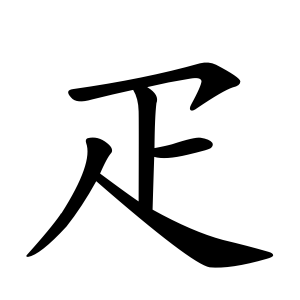疋
- a pair;
- the leg below the knee;
Etymology
The upper part represents the calf, and the lower part, 止, is a pictograph of a foot.
It can be confused with the character 正 (jeong), meaning "correct" or "straight," because of their visual similarity. However, 正 has a straight and upright form, while 疋 (필) includes additional decorative strokes that distinguish it.
Usage in Korean
It has multiple readings and meanings, including:
짝 필 ("paired"):
This specifically refers to two pairs (four items). A single pair (two items) is called 량 (兩), while two pairs that form one set are called 필 (疋)—thus 疋 represents four as two pairs.
발 소 ("foot"):
The original pronunciation is “seo”, but it has somehow become “so” as a secondary or colloquial pronunciation.
바를 아 ("correct"):
In this sense, it is interchangeable with 雅 (elegant, correct).
Alternative forms
Characters with 疋
- 弓卜人 (NYO)
- ⿱ 乛 龰
